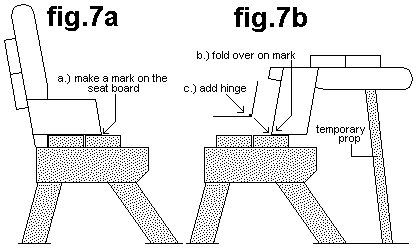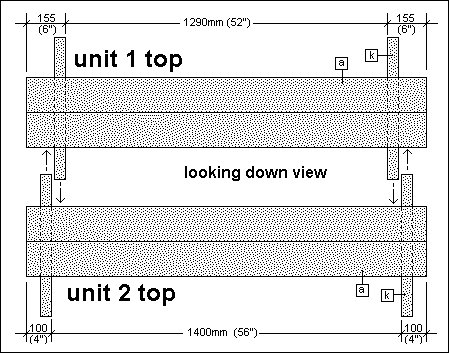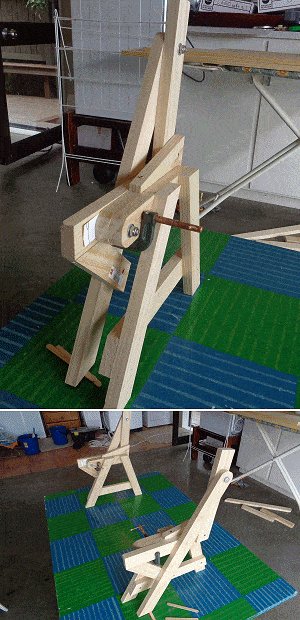Contents
[su_frame class=”responsive-image”]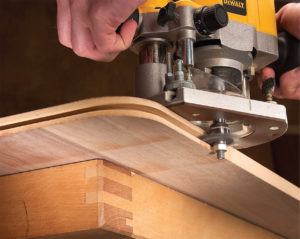 [/su_frame]
[/su_frame]
Are you seeking ways to round wood edges? Several woodwork aficionados have different approaches to rounding edges. Generally, this process can be tricky especially when you aren’t sure whether to use a router or not.
In this post, we describe the processes involved in turning sharp edges into round ones. Typically, rounding the edges of woodworks allows you to protect yourself, kids, pets, or other family members from accidents involving tables and chair legs.
Rounded wood edges also make painted surfaces more appealing when compared with sharp edges. In fact, musical instruments such as pianos and guitars have their solid and pleasant appearance thanks to the rounding of their edges.
Lastly, when you round edges, you make the piece of furniture durable and indestructible from likely falls or crashes.
As a woodworking enthusiast, you might be concerned about gathering expensive tools that you might not use frequently. Nonetheless, this post explains the possibility of routing wood edges or using alternative tools to achieve woodwork rounding.
[note]Note that we take you first through the procedures of routing wood edges, and second, through the steps of rounding wood edges without a router.[/note]
Required Tools for this Project
Since the woodwork rounding project can be done in two methods, the tools for each method vary. Nonetheless, the overall aim of both patterns of rounding is to give the wood a smooth, soft surface that causes no harm and absorbs paint nicely.
If you decide to go the traditional way, sandpaper would an option. However, the downside with this regular tool is the fact that it takes a lot of time and can be difficult in terms of consistency. While you might achieve smoothness on some edges, other corners might appear different.
Hence, if you choose to round wood edges with a wood router, you might want to choose one with variable-speed or the lock trigger functionality. Your choice router usually allows you to achieve your imagined/ideal results.
[su_spoiler title=”Additional tools you’ll need when working with a router include:” open=”yes” style=”simple” icon=”plus” anchor=”” class=””]
[su_list icon=”icon: arrow-circle-right” icon_color=”#4f8901″]
- Round over cutter
- Scrap material
- Safety glasses
- Ear protection (earplugs)
- Hot melt glue gum
- Sanding block
- Dust mask
[/su_list]
[/su_spoiler]
However, if you decide to round wood edges without a router, the most important tool is the hand plane. From the jointer plane, smoothing plane, block plane to the jack plane, your choice of hand plane should be closely linked to the woodwork project you intend to work on.
In addition, the length of the handheld tool you select largely contributes to the success of your rounding project. Larger objects require jointer or smoothing planes whereas the jack and block planes are easier to use if you’re working on smaller objects or you’re using the tool for the first time.
[su_spoiler title=”If you don’t have a hand plane, you could try any of these alternatives:” open=”yes” style=”simple” icon=”plus” anchor=”” class=””]
[su_list icon=”icon: arrow-circle-right” icon_color=”#4f8901″]
- Cornering tools
- Card scrapper
- Chisel
- File
- Scratch stock
- Spokeshave
[/su_list]
[/su_spoiler]
How to Round Wood Edges With Router
[su_dropcap style=”flat” size=”2″ class=”” dropcap_color=”#fa5738″]1[/su_dropcap]
Route the ends before the sides
[su_divider top=”no” style=”default” divider_color=”#444″ size=”3″ margin=”15″ class=””]
[su_row class=””]
[su_column size=”1/2″ center=”no” class=””]
When routing a board, begin with the ends before the sides to prevent splitting the already-routed sides. If you begin with the ends and move on to the sides, you could easily repair poor edges that might have occurred on the sides.
[/su_column]
[su_column size=”1/2″ center=”no” class=””]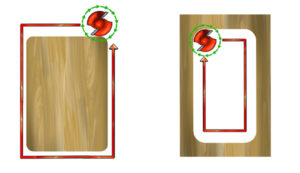 [/su_column]
[/su_column]
[/su_row]
For inner edges of a wood piece, say a painting frame, move your router in the clockwise direction. But for outside edges of a board, for example, turn the router in counterclockwise motion for easy control.
[su_dropcap style=”flat” size=”2″ class=”” dropcap_color=”#fa5738″]2[/su_dropcap]
Support Thin Wood Pieces with Scrap Materials
[su_divider top=”no” style=”default” divider_color=”#444″ size=”3″ margin=”15″ class=””]
[su_row class=””]
[su_column size=”1/2″ center=”no” class=””]
When working with thinner boards, clamping the wood to your workbench might not be a good idea. Routing could lead to some form of damage to your workbench.
Instead, place a scrap material that’s relatively thicker than your strip behind or below the piece you’re routing. Otherwise, consider sticking the scrap material and the actual wood piece you intend to route using hot-melt glue.
After the routing process, remove the glue using a putty knife.
[/su_column]
[su_column size=”1/2″ center=”no” class=””]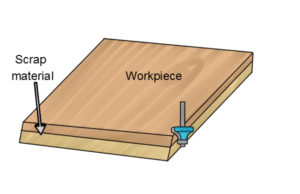 [/su_column]
[/su_column]
[/su_row]
[su_dropcap style=”flat” size=”2″ class=”” dropcap_color=”#fa5738″]3[/su_dropcap]
Set Your Cutting Depth and Rout
[su_divider top=”no” style=”default” divider_color=”#444″ size=”3″ margin=”15″ class=””]
[su_row class=””]
[su_column size=”1/2″ center=”no” class=””]
Choose your preferred cutter and fit into the router’s collet. Next, place the router on the piece of wood and adjust the depth until you achieve the ideal length. The router bit is the most important part for routing edges but you could make additional cuts by lowering or raising the bit.
[/su_column]
[su_column size=”1/2″ center=”no” class=””]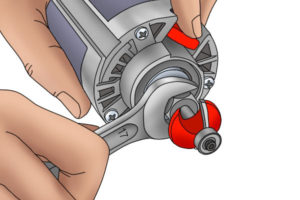 [/su_column]
[/su_column]
[/su_row]
[su_dropcap style=”flat” size=”2″ class=”” dropcap_color=”#fa5738″]4[/su_dropcap]
Inspect Your Rounded Workpiece
[su_divider top=”no” style=”default” divider_color=”#444″ size=”3″ margin=”15″ class=””]
After the routing, turn off your router and check your rounded edges. If you observe any areas you need to redo, feel free.
How to Round Wood Edges Without Router
[su_dropcap style=”flat” size=”2″ class=”” dropcap_color=”#fa5738″]1[/su_dropcap]
Select the Best Hand Plane for Your Wood Project
[su_divider top=”no” style=”default” divider_color=”#444″ size=”3″ margin=”15″ class=””]
[su_row class=””]
[su_column size=”1/2″ center=”no” class=””]
Since different wood projects require different tools, it’s essential that you select the plane that works best for you. Block planes are ideal for thin wood pieces while jack planes are perfect for both short and longboards.
Jointer planes are preferred for larger boards or frames such as doors whereas smoothing planes are used to level all sorts of surfaces.
[/su_column]
[su_column size=”1/2″ center=”no” class=””]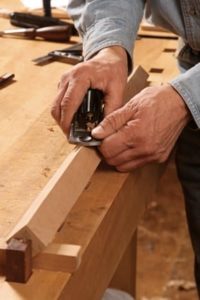 [/su_column]
[/su_column]
[/su_row]
[su_dropcap style=”flat” size=”2″ class=”” dropcap_color=”#fa5738″]2[/su_dropcap]
Plan Your Rounding with a Cutter with the Right Radius
[su_divider top=”no” style=”default” divider_color=”#444″ size=”3″ margin=”15″ class=””]
[su_row class=””]
[su_column size=”1/2″ center=”no” class=””]
If this is your first time rounding edges without a router, we recommend that you add around over cutter to your hand plane. This helps you plan for accuracy. Note that you can skip this layout planning when you become a pro.
[/su_column]
[su_column size=”1/2″ center=”no” class=””]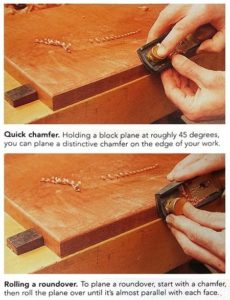 [/su_column]
[/su_column]
[/su_row]
[su_row class=””]
[su_column size=”1/2″ center=”no” class=””]
[su_dropcap style=”flat” size=”2″ class=”” dropcap_color=”#fa5738″]3[/su_dropcap]
Cut Your Chamfer at 45-degrees
[su_divider top=”no” style=”default” divider_color=”#444″ size=”3″ margin=”15″ class=””]
Cutting a chamfer requires you to maintain a straight cut on your layout lines with a long plane. This move should give you two corners.[/su_column]
[su_column size=”1/2″ center=”no” class=””]
[su_dropcap style=”flat” size=”2″ class=”” dropcap_color=”#fa5738″]4[/su_dropcap]
Plane Down Corners
[su_divider top=”no” style=”default” divider_color=”#444″ size=”3″ margin=”15″ class=””]
To get your desired rounded edge, put your hand plane to each corner of the chamber until you have four corners.[/su_column]
[/su_row]
[su_dropcap style=”flat” size=”2″ class=”” dropcap_color=”#fa5738″]5[/su_dropcap]
Finish
[su_divider top=”no” style=”default” divider_color=”#444″ size=”3″ margin=”15″ class=””]
As a final step, smooth the four corners so that they each have leveled surfaces or the desired rounded edges.
Overall, we hope that this post has successfully taught you how to round wood edges using a router or hand plane. What’s your preferred rounding method?






